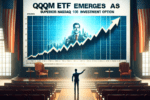New York City, NY – An investor in the Nasdaq 100 shares insights on why they made the switch to the Invesco NASDAQ 100 ETF, emphasizing its advantages for long-term investments. The decision to pivot from the Invesco QQQ Trust ETF to the QQQM ETF was driven by a desire for increased exposure to the Nasdaq 100 over the long haul.
In a comparison between the QQQ and QQQM ETFs, key differences emerged in terms of size, expense ratios, and bid/ask spreads. While the QQQ ETF boasts a significantly larger Asset Under Management compared to QQQM, the latter offers a lower expense ratio. Additionally, the QQQ ETF has a competitive bid/ask spread of 0.005%, whereas the QQQM ETF features a slightly higher median bid/ask spread of 0.01%.
The investor recommends the QQQM ETF for those seeking mid to long-term exposure to the Nasdaq 100, citing its lower fees and favorable performance since its inception in 2020. On the other hand, due to higher liquidity and a negligible bid/ask spread, the QQQ ETF remains the preferred choice for investors looking to trade the Nasdaq 100 frequently.
The launch of the QQQM ETF in 2020 raised questions about its similarity to the QQQ ETF, with Blackrock positioning QQQ as the primary option for short-term traders and QQQM as a cost-effective alternative for long-term holders. This strategic move aligns with a broader trend in the ETF market, with other journalists noting the differentiation between the two offerings.
Comparing QQQM with other tech-heavy ETFs like SCHG, VGT, and VUG sheds light on the competitive landscape of the sector. While QQQM excels in expense ratio compared to QQQ, it faces stiff competition from these other ETFs, each with its unique investment strategy and focus.
Despite the similarities in holdings between QQQ and QQQM, subtle differences in expense ratios have led to a slight overperformance of QQQM since late 2020. This trend underscores the impact of fees on investment performance over time, with low fees being a key driver of higher investor returns according to a Morningstar study.
While the QQQM ETF stands out for its efficiency and low expense ratio, potential risks lie in its higher bid/ask spread, making it less ideal for daily traders. For investors looking to capitalize on frequent trading opportunities in the Nasdaq 100, the QQQ ETF remains the preferred choice due to its enhanced liquidity and lower bid/ask spread.
In conclusion, for the investor, the QQQM ETF represents the optimal choice for gaining exposure to the Nasdaq 100 index, given its cost-effectiveness and long-term investment horizon. However, the article stresses the importance of aligning investment choices with individual trading preferences and goals to maximize returns.










